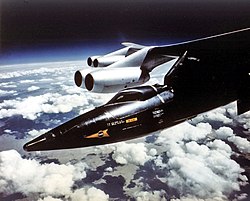Top Qs
Timeline
Chat
Perspective
1963 in spaceflight
From Wikipedia, the free encyclopedia
Remove ads
Quick facts Orbital launches, First ...
 A North American X-15 made two suborbital flights in July and August, becoming the first reusable spacecraft | |
| Orbital launches | |
|---|---|
| First | 4 January |
| Last | 21 December |
| Total | 70 |
| Successes | 50 |
| Failures | 17 |
| Partial failures | 3 |
| Catalogued | 55 |
| Rockets | |
| Maiden flights | Atlas LV-3A Agena-D Atlas LV-3C Centaur-B Polyot 11A59 Scout X-2B Scout X-3M Scout X-4 Thor DSV-2A Ablestar TAT SLV-2A Agena-B TAT SLV-2A Agena-D Voskhod 11A57 |
| Retirements | Atlas LV-3B Atlas LV-3C Centaur-B Scout X-2B Scout X-2M Scout X-3M |
| Crewed flights | |
| Orbital | 3 |
| Suborbital | 2 |
| Total travellers | 4 |
Close
Remove ads
Orbital and Suborbital launches
Deep space rendezvous
More information Date (GMT), Spacecraft ...
| Date (GMT) | Spacecraft | Event | Remarks |
|---|---|---|---|
| 5 April | Luna 4 | Flyby of the Moon | Failed lander, closest approach: 8,336 kilometres (5,180 mi) |
| 19 June | Mars 1 | First flyby of Mars | Closest approach: 193,000 kilometres (120,000 mi), communications system failed before flyby |
Close
Notable creations of orbital debris
More information Date/Time (UTC), Source object ...
| Date/Time (UTC) | Source object | Event type | Pieces tracked | Remarks |
|---|---|---|---|---|
| 9 May[1] | Westford-2 | Communications experiment | 46[1] | As part of an experiment to facilitate international telecommunications, the US Military deployed an artificial space ring consisting of hundreds of millions of tiny copper needles[2] which would act as antennas reflecting radio signals at the target wavelength of 8 GHz. A large proportion of the needles were not dispersed properly and remained stuck in clumps that were discovered and tracked by the SSN between 1966 and 1991. As of October 2013[update], 46 of the 144 detected debris clumps remain in orbit.[1] The needles that were properly dispersed are believed to have decayed.[1]
This event prompted international protests[3][4][5][6] and influenced the drafting of the 1967 Outer Space Treaty.[3] |
Close
Orbital launch statistics
By country
More information Country, Launches ...
| Country | Launches | Successes | Failures | Partial failures | |
|---|---|---|---|---|---|
| 24 | 15 | 9 | 0 | ||
| 46 | 35 | 8 | 3 | ||
| World | 70 | 50 | 17 | 3 | |
Close
By rocket
More information Rocket, Country ...
Close
By orbit
More information Orbital regime, Launches ...
| Orbital regime | Launches | Achieved | Not Achieved | Accidentally Achieved |
Remarks |
|---|---|---|---|---|---|
| Low Earth | 57 | 44 | 13 | 2 | |
| Medium Earth | 5 | 4 | 1 | 0 | |
| High Earth | 5 | 3 | 2 | 0 | Including Highly elliptical orbits |
| Geosynchronous/transfer | 2 | 2 | 0 | 0 | |
| Heliocentric | 1 | 0 | 1 | 0 |
Close
Remove ads
References
Wikiwand - on
Seamless Wikipedia browsing. On steroids.
Remove ads
Remove ads
